See you again in 2014.
Tuesday, December 24, 2013
Monday, October 14, 2013
Blog on hiatus
Hello everybody!
I'm here to write that my blog will be on hiatus for a while. The reasons led to this are my computer (broken hard drive and graphics card) and career college, which takes about 9 hours of my day on weekdays. Without a working computer it is impossible to transfer the photos to internet, without significantly dropping in quality for example in photos taken by a smartphone camera. I want to keep the quality of the posts and photos at least as high as theu are now so the best choise will be to put the blog on hiatus. No worries because I'll be back as soon as possible. Thank you very much for reading my blog and see you soon! :)
I'm here to write that my blog will be on hiatus for a while. The reasons led to this are my computer (broken hard drive and graphics card) and career college, which takes about 9 hours of my day on weekdays. Without a working computer it is impossible to transfer the photos to internet, without significantly dropping in quality for example in photos taken by a smartphone camera. I want to keep the quality of the posts and photos at least as high as theu are now so the best choise will be to put the blog on hiatus. No worries because I'll be back as soon as possible. Thank you very much for reading my blog and see you soon! :)
Thursday, September 12, 2013
New plants and last days of T.R.A.P.
Howdy howdy everybody!
Yesterday two new epiphytic Utricularia arrived to my collections and these plants are
U. longifolia x alpina and
U. nephrophylla x geminiloba.
Thanks to Dafinka from darwiniana.cz.
Last week I received plants fron CarniSana, which I already gave you a brief review. Gorgeous Heliamphora heterodoxa x minor, which was the main course of the packet was over my expectations with many vigorous growing points.
Hopefully the Heli will thrive in my so called "highland" terrarium, of which I don't have specific information of temperatures or humidity, but as soon as soon as I have some some more info I will update it here. This highland terrarium is a used aquarium on near floor level and under a window to provide extra cooling.
Much Changes have come in growing my plants because I had to fit my plants in two terrariums, which made me to sort these plants into two groups, heat lovers and cool growers. Among heat lovers is my newest glistering jewel, the last Queensland sister I did not own, funny looking Drosera prolifera.
So here is the T.R.A.P. shown. In the terrarium "heat lovers" there are all of my Nepenthes pitcher plants, Queensland and petiolaris complex Drosera, Drosera oblanceolata and nearly all of my terrestrial Utricularia and Genlisea. After long search of easy to grow Genlisea I found at last G. flexuosa and pygmea which are flowering to me at the moment.
Cool growers include epiphytic Utricularia, leftovers of Drosera, Genlisea and Utricularia plus Heliamphora and Brocchinia reducta, which is one of the most vigorously growing plants recently in my collections. Arrived with three leaves, which are already long gone, and now looks like this. Still nothing happened in the size, but the growing speed is good.
Well everything can't go perfectly jo my lamp decided to go dark and my plants in "highland" terrarium need to grow under warm white fluorescent tube until I get another plant tube.
One of the best things happened (right after getting my stitches away) in this week is that one of my most waited plant hybrids has become reality in form of U. asplundii x jamesoniana, which you can see pictures of in CPPF or take a look at the original thread in CPUK. Now to just wait until someone crosses U. asplundii or U. jamesoniana with U. campbelliana or U. quelchii. My list of wanted plants just keeps getting longer and longer when U. asplundii x jamesoniana is added to it.
I have seed grown U asplundii but they are still pretty small plants and in next season I'm considering of buying U. jamesoniana which is said to be a bit challenging because of it's small size, which is why it is easily overgrown by moss.
So my small scale holiday is soon to over and for me it is return to study writing, communication, adobe illustrator, school security and history of arts among many other subjects. Hopefully studies to become a media assistant will also helm me make this blog better to read for you all. Next blog post will most likely focus on temperate plants and how I will prepare them for dormancy. Until my next post, happy growing and sunshine to all of you!
Yesterday two new epiphytic Utricularia arrived to my collections and these plants are
U. longifolia x alpina and
U. nephrophylla x geminiloba.
Thanks to Dafinka from darwiniana.cz.
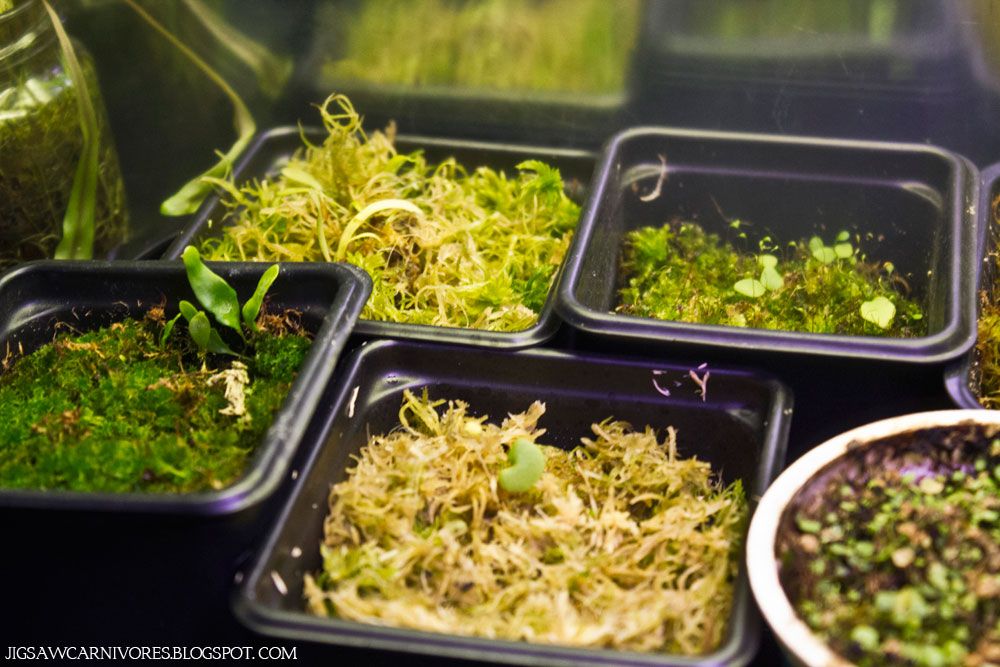 |
| Clockwise from bottom front, U. nephrophylla x geminiloba, U. alpina x endresii, U. longifolia, U. longifolia x alpina, U. geminiloba and U. nephrophylla |
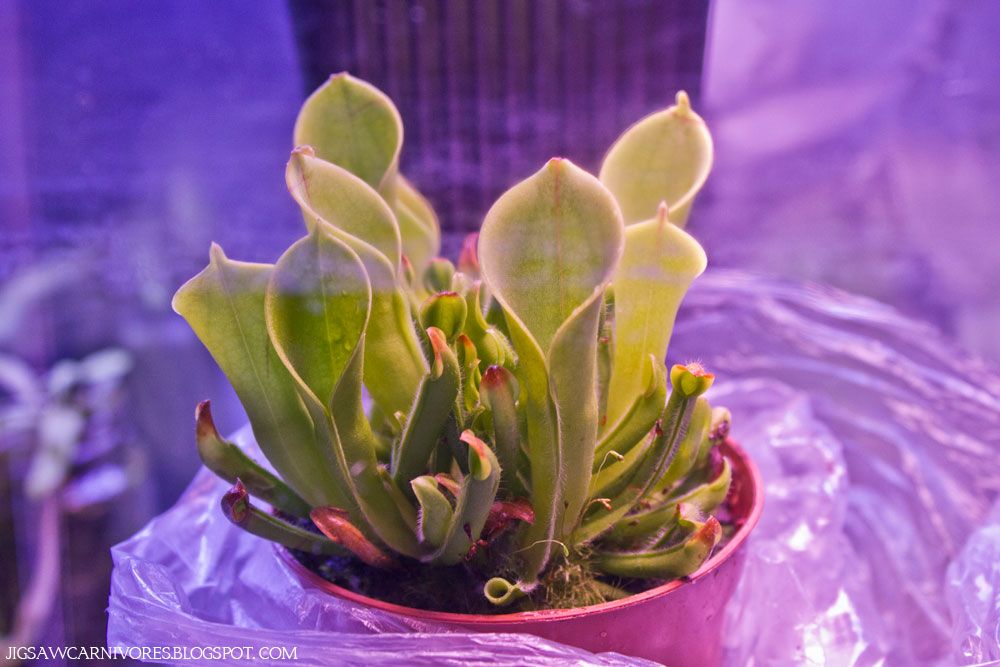 |
| Heliamphora heterodoxa x minor |
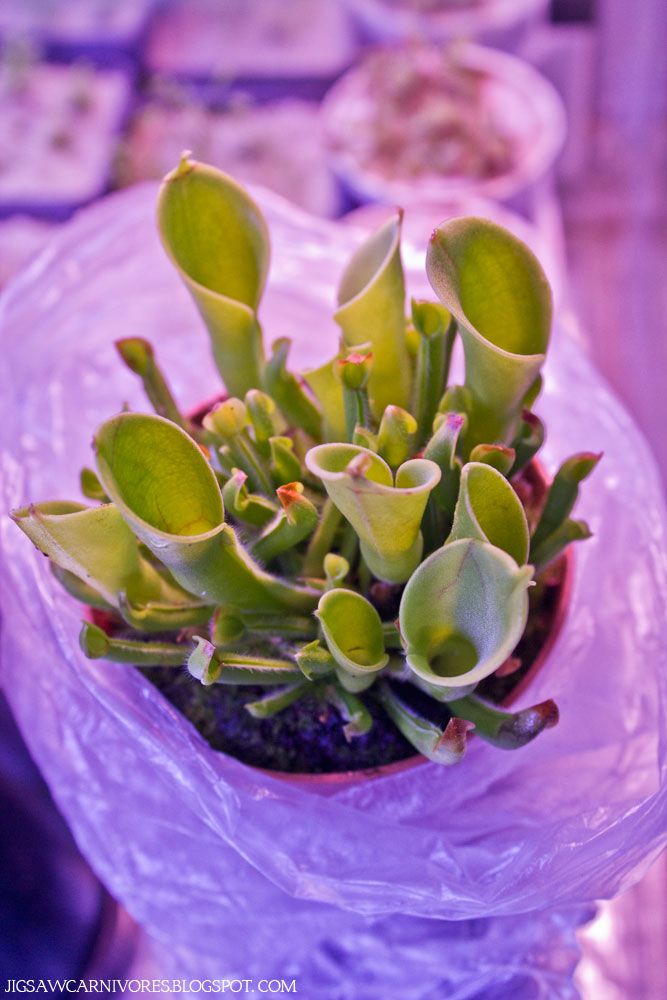 |
| Heliamphora heterodoxa x minor |
Much Changes have come in growing my plants because I had to fit my plants in two terrariums, which made me to sort these plants into two groups, heat lovers and cool growers. Among heat lovers is my newest glistering jewel, the last Queensland sister I did not own, funny looking Drosera prolifera.
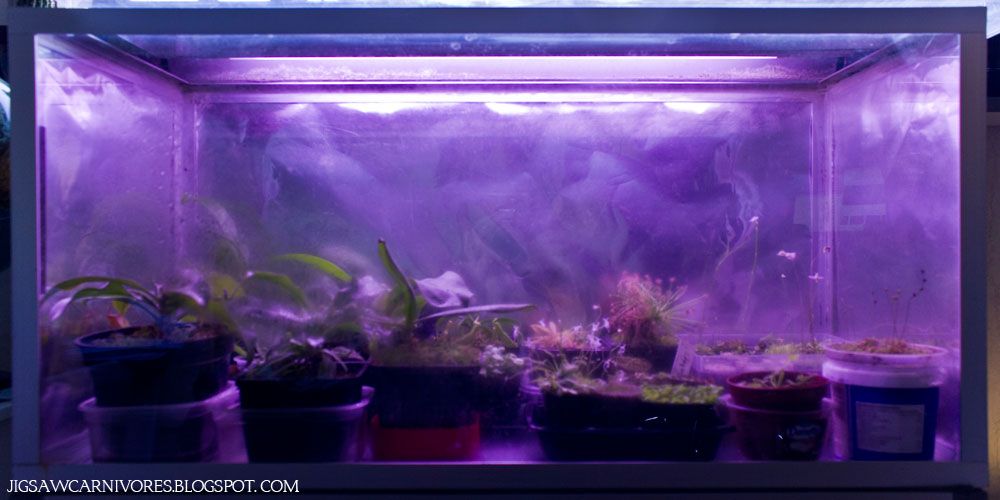 |
| Lowland terrarium |
 |
| Wet corner including terrestrial Utricularia and Genlisea |
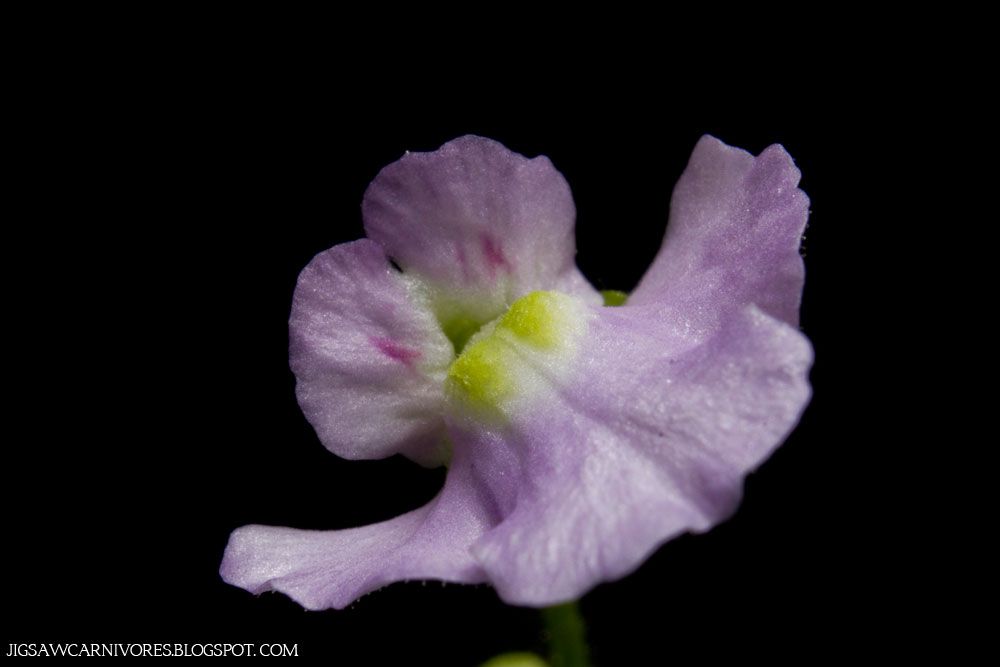 |
| Genlisea flexuosa from Furnas |
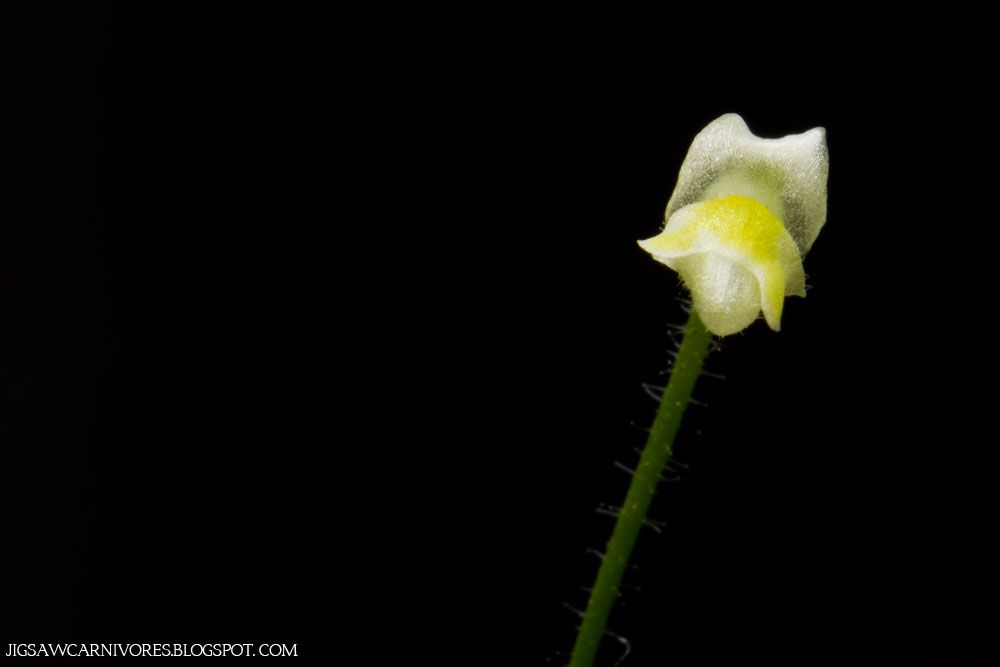 |
| Genlisea pygmea |
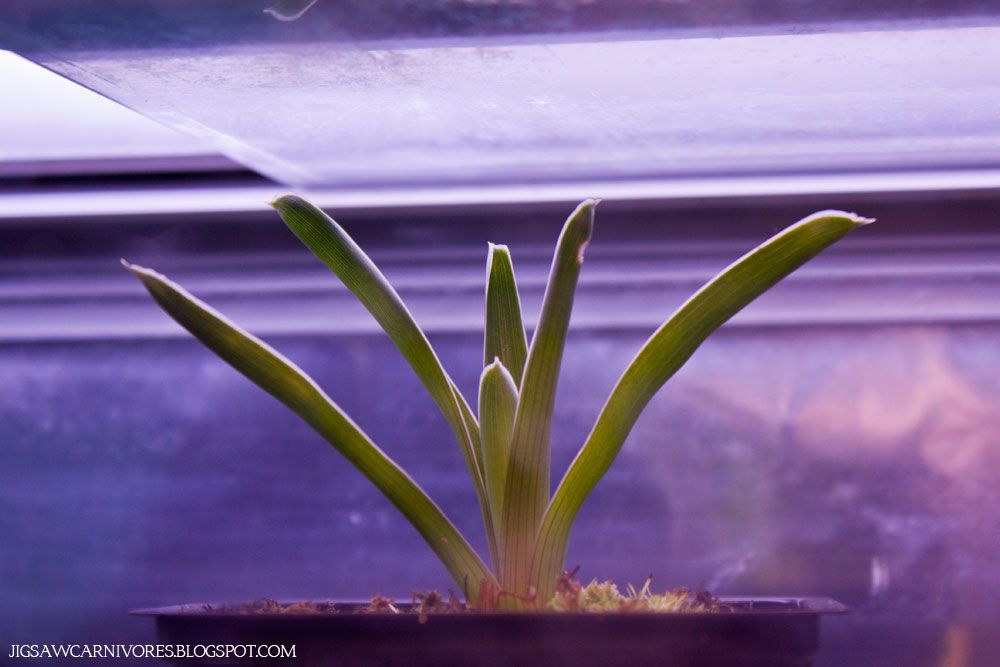 |
| Brocchinia reducta |
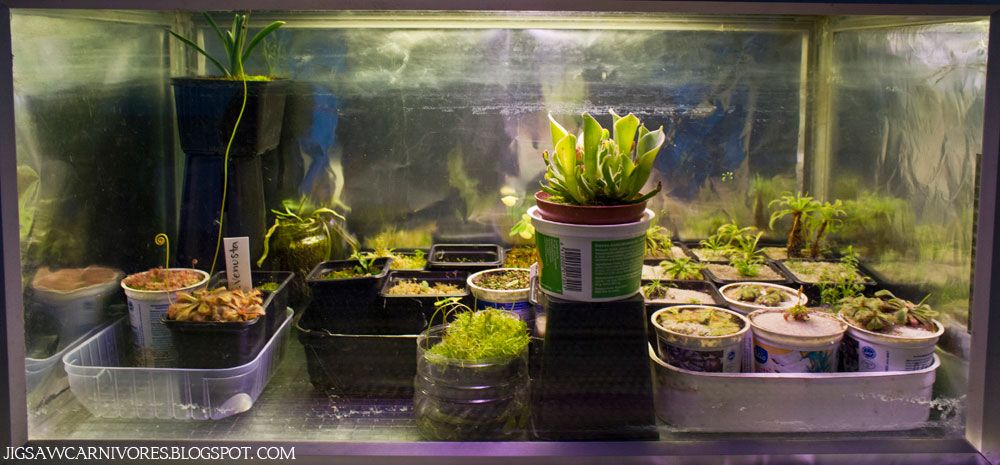 |
| "Highland" terrarium |
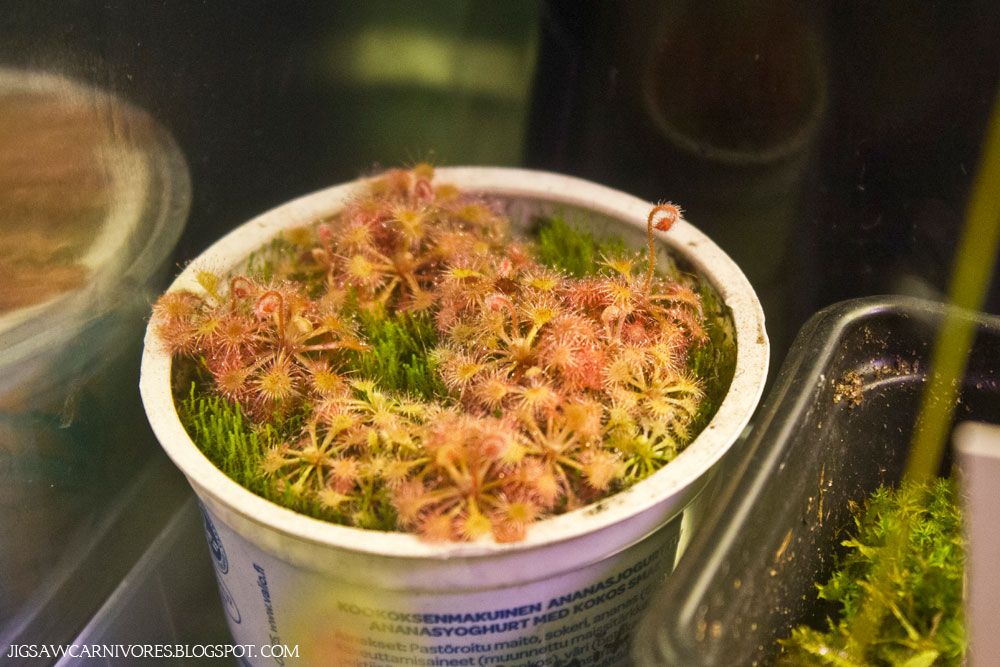 |
| Drosera kaiteurensis soon to bloom |
One of the best things happened (right after getting my stitches away) in this week is that one of my most waited plant hybrids has become reality in form of U. asplundii x jamesoniana, which you can see pictures of in CPPF or take a look at the original thread in CPUK. Now to just wait until someone crosses U. asplundii or U. jamesoniana with U. campbelliana or U. quelchii. My list of wanted plants just keeps getting longer and longer when U. asplundii x jamesoniana is added to it.
I have seed grown U asplundii but they are still pretty small plants and in next season I'm considering of buying U. jamesoniana which is said to be a bit challenging because of it's small size, which is why it is easily overgrown by moss.
So my small scale holiday is soon to over and for me it is return to study writing, communication, adobe illustrator, school security and history of arts among many other subjects. Hopefully studies to become a media assistant will also helm me make this blog better to read for you all. Next blog post will most likely focus on temperate plants and how I will prepare them for dormancy. Until my next post, happy growing and sunshine to all of you!
Thursday, September 05, 2013
T.R.A.P. and some newbies
Hello my dear readers! First of all I'm sorry for not writing here for a long time. At the moment I'm studying in career college, and my subject is audiovisual communication (graphic design and multimedia especially). Daily the career college takes me from seven to nine hours including over one hundred kilometers traveling on bus. Also my health hasn't been the best but after a surgery and few days in hospital I'm good as new and now having more time to write to you during my two week holiday.
Project T.R.A.P. comes fron Terrarium Re Arrangement Project, which is because the autumn is coming and I need to fit all my plants indoors and also fit my new plants in.
Because of my new plants and trying a new webshop I'll give you a small review of the Polish carnivorous plants webshop CarniSana, which you can find at http://www.carnisana.pl/
I left my order in the middle of the week and next day I had my first email from them on 21st of August including summary of my order, contacts and a bank account number. I paid them but during the next week they faced some unexpected problems in sending plants so they sent me my order on Monday 2nd of September, which was actually good thing for I was in the hospital when the packet was meant to originally arrive. Today I received the packet including the following plants:
Dionaea muscipula 'Bohemian Garnet' (bonus plant)
Dionaea muscipula 'Cup Trap' (bonus plant)
Drosera prolifera
Heliamphora heterodoxa x minor
All of them in best conditions as plants can be after shipping up to Finland from Poland. Also Heliamphora was shipped potted and packed carefully, plant having multiple gorgeous growing points. Two lovely small flytraps will definitely make it up for the extra week and I believe the delay in my case was just pre-winter rush when everybody wants new plants before winter.
Summary of the webshop: Absolutely great webshop. Selection is good, prices are just right, service is friendly and fast. Definitely check out if you want to have new plants before winter!
Sorry no pics for you this time butpics of my new plants and also the old ones will be included in a blog post which will be published within a week. Until then, happy growing!
Project T.R.A.P. comes fron Terrarium Re Arrangement Project, which is because the autumn is coming and I need to fit all my plants indoors and also fit my new plants in.
Because of my new plants and trying a new webshop I'll give you a small review of the Polish carnivorous plants webshop CarniSana, which you can find at http://www.carnisana.pl/
I left my order in the middle of the week and next day I had my first email from them on 21st of August including summary of my order, contacts and a bank account number. I paid them but during the next week they faced some unexpected problems in sending plants so they sent me my order on Monday 2nd of September, which was actually good thing for I was in the hospital when the packet was meant to originally arrive. Today I received the packet including the following plants:
Dionaea muscipula 'Bohemian Garnet' (bonus plant)
Dionaea muscipula 'Cup Trap' (bonus plant)
Drosera prolifera
Heliamphora heterodoxa x minor
All of them in best conditions as plants can be after shipping up to Finland from Poland. Also Heliamphora was shipped potted and packed carefully, plant having multiple gorgeous growing points. Two lovely small flytraps will definitely make it up for the extra week and I believe the delay in my case was just pre-winter rush when everybody wants new plants before winter.
Summary of the webshop: Absolutely great webshop. Selection is good, prices are just right, service is friendly and fast. Definitely check out if you want to have new plants before winter!
Sorry no pics for you this time butpics of my new plants and also the old ones will be included in a blog post which will be published within a week. Until then, happy growing!
Thursday, July 25, 2013
Medium sized update with photos #1
Howdy howdy. Long time no see huh. Well I can't see you but... you get the idea. Holiday is over and today I took part in qualification test for career college, the results come during next week's Friday. Keep your fingers crossed for me.
Sometimes it's refreshing to start a meal with dessert so here we go with some Utricularia flowers.


Then to my wannabe highland terrarium, which is for now a plastic box on my floor. The upper row D. venusta, G. roraimensis, U. asplundii and U. reniformis small form. Middle earth, I mean row D. natalensis with location data, D. roraimensis, D. regia. The sugar on the bottom is D. felix, U, nephrophylla and dead D. graomogolensis. D. graomogolensis was a bit ex tempore but I agreed to swap it for few sundews but unluckily the plant arrived when I was on my holiday and my parents potted it.
Rule number X: Never let your parents pot your carnivorous plants, unless they're carnivorous plants hobbyists too. Mine aren't.

D. natalensis from Inanda road, Waterfall, Kwa-Zulu, Natal, RSA and D. kaiteurensis. Oops! File name of the picture says D. roraimensis. Maybe I'm getting old or I just have too many plants. :D
Drosera venusta is a true fighter. Now it is growing perfectly with even a flowerstalk.

Well here are the pictures for now. During the next week I'll post more Take care of yourself and your plants, beware closed greenhouses. Happy growing!
U. sandersonii, which I get to bloom first time in my whole hobby!
U. dichotoma, first time blooming in my collection.Notice powdery mildew which attacked the flowerstalk.

U. uniflora took it's time to bloom but glad it did. Seems like this one likes the summery heat.

Then to my wannabe highland terrarium, which is for now a plastic box on my floor. The upper row D. venusta, G. roraimensis, U. asplundii and U. reniformis small form. Middle earth, I mean row D. natalensis with location data, D. roraimensis, D. regia. The sugar on the bottom is D. felix, U, nephrophylla and dead D. graomogolensis. D. graomogolensis was a bit ex tempore but I agreed to swap it for few sundews but unluckily the plant arrived when I was on my holiday and my parents potted it.
Rule number X: Never let your parents pot your carnivorous plants, unless they're carnivorous plants hobbyists too. Mine aren't.
U. asplundii are growing bigger leaves than before. I'll pot them in spahnum soon and hopefully it will improve their growing.

D. natalensis from Inanda road, Waterfall, Kwa-Zulu, Natal, RSA and D. kaiteurensis. Oops! File name of the picture says D. roraimensis. Maybe I'm getting old or I just have too many plants. :D
Drosera venusta is a true fighter. Now it is growing perfectly with even a flowerstalk.

I was shocked when I came home and saw my Darlingtonia with only few leaves. The biggest leaves had dried away and below is a picture that might reveal the reason why it all happened.
The base of the plant has turned purple coloured, which I think might be a symptom of fungal infection. Well at least I treated My Darling with some fungicide. But if you recognize this symptom and it is about something else than fungal infection, please comment or e-mail.
Well here are the pictures for now. During the next week I'll post more Take care of yourself and your plants, beware closed greenhouses. Happy growing!
Thursday, July 04, 2013
Twin blog
Hello my dear readers. I apologize for not getting any new material for this blog for a while, but it will change in a week or two, when there will be a giant update. Giant update doesn't sound right, let's say few nice updates in a week.
Also I want to advertise my twin blog about carnivorous plants, which will be posted in Finnish and it is at http://tappajakasvit.blogspot.fi/
This blog will mostly include the same things as in here but in Finnish but also some updates directed more towards Finns and giving more advice for people who have just bought their first carnivorous plants.
If you're a Finn or Finnish speaker or have chosen one of the most annoying second language to learn, please head to http://tappajakasvit.blogspot.fi/
Cheers!
Also I want to advertise my twin blog about carnivorous plants, which will be posted in Finnish and it is at http://tappajakasvit.blogspot.fi/
This blog will mostly include the same things as in here but in Finnish but also some updates directed more towards Finns and giving more advice for people who have just bought their first carnivorous plants.
If you're a Finn or Finnish speaker or have chosen one of the most annoying second language to learn, please head to http://tappajakasvit.blogspot.fi/
Cheers!
Monday, July 01, 2013
The great poll!
Howdy again. I just can't keep you from spamming.
Today I added a poll which will unofficially answer the question that many people have wondered about: What is the best carnivorous genera? To make it a bit easier for you to give your opinion you can choose multiple genera. You have time to vote until end of the year and in the next year I will make a bi-ig update of your most liked genera. Vote your favorite genera and prepare for a surprise.
Cheers!
Today I added a poll which will unofficially answer the question that many people have wondered about: What is the best carnivorous genera? To make it a bit easier for you to give your opinion you can choose multiple genera. You have time to vote until end of the year and in the next year I will make a bi-ig update of your most liked genera. Vote your favorite genera and prepare for a surprise.
Cheers!
Wednesday, June 26, 2013
Holiday report
Well you happen to have one dam lucky author here, because there were hundreds of Drosera rotundifolia growing on this swamp. The sphagnum was pretty dense compared to most of the swamps I've been to and it only pressed down few centimeters under my feet.
The swamp seemed pretty untouched, mostly because of it's location (Ain't gonna tell you the precise location. Hahaha!) and because there grew no cloudberries, which are some of the most delicious berries growing in Finland (But not in my opinion. I agree with Gordon Ramsay when he visited Finland and tasted cloudberry jam he just asked "Do you feed this for your horses?")
The diversity in this population is pretty good for just being few hundred plants. There were mostly youngish I'd say 2-3 years old plants with a diameter about 5 cm (2"). They grew on sphagnum and most of them had erect leaves. The plant in the following picture is about 9 cm (3.5") in diameter and the leaves have a nice nice upward curve.
The plants had in general a very rich red coloration and as you can see most of the sundews there are soon ready to bloom. I mus consider returning there few days later to see how's the flowering.
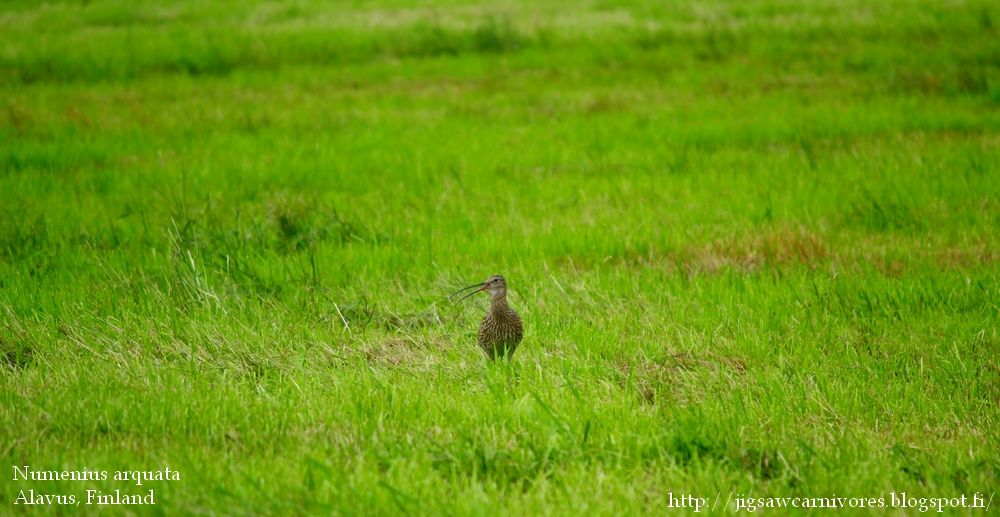 |
| "Squa--wk!" |
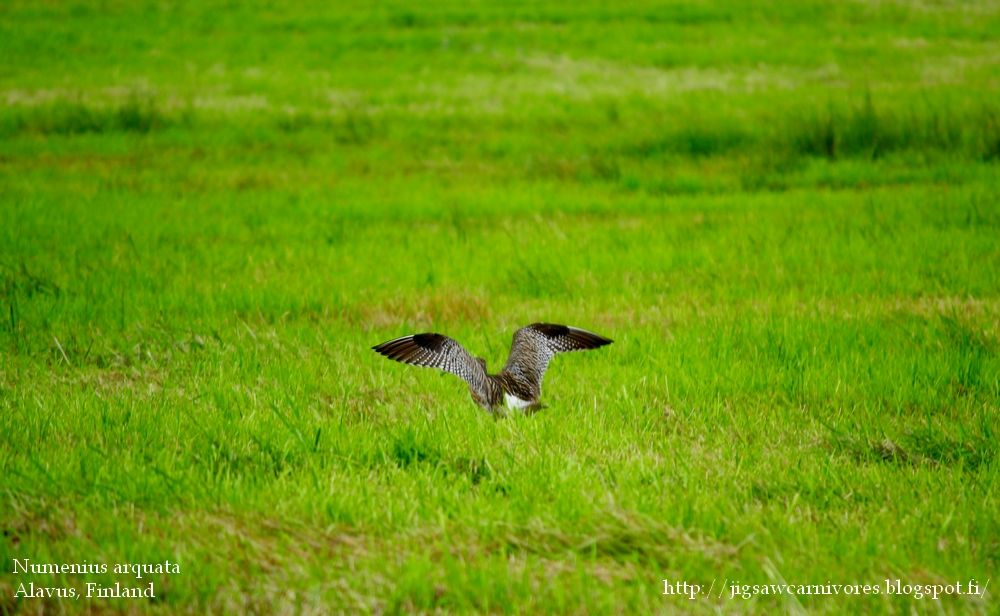 |
| "Got 2 go. Bye!" |
And yes, I had to look if there were some birds too. In nearby fields I saw Numenius arquata or Eurasian Curlew which happens to be Finland's largest wader.
Now that's all for a while. As soon as I get home it will be time to order some new plants and try a new web shop. After my N. 'Rebecca Soper' died it left a large empty spot in my main terraria, and that one spot needs to be filled. But hey, one reader's wish has come true. This is how the sundews grow in Finnish nature. If you have something you would like me to write more about then please leave a comment or send me e-mail to kihokki01[at]gmail.com and I'll try to work it out somehow. Now it is getting tan and all summery stuff for me. Got to go but see you later!
Monday, June 17, 2013
The mistakes I regret in this hobby
Hello everybody!
When repotting some of my old sundews I started thinking my past in this hobby. I do regret losses of some plants and doing things wrong way and here is a blog post about them, just to show you that you can learn from your mistakes.
1. Nepenthes 'Rebecca Soper' my latest loss. Month or so ago plants three largest stems dried for no good reason so I cut them off. Few weeks ago the plant had two smaller growing points, of which one had mold attack and another just turned black. This is one of my fav neps and it was really hard to see it doing so bad. After all life was gone from the pot I just tuck my hand in the pot and scooped the media on a newspaper and I was terrified to see how the soil had become a snail and slug farm. I then took the media outside and boiled it to kill the slugs and snails and keeping them from not infesting my or my neighbor's gardens. Rule number one when dealing with ready potted plants: Replace the original, possibly slug infested soil, with your own soil mix. Also be sure to use clean pots.
2. Drosera slackii with a rule Don't buy a fancy plant without making sure you can provide it the conditions it needs. When I saw D. slackii on the internet I just thought "WHoa! A sundew that can grow up to 9 cm wide. I gotta get that now." I did not do enough googlin' about the species, which likes more cooler temperatures than I could provide to it. Well sphagnum based potting mix could have saved it but it was just too late. Do your homework so you don't need to write angst filled blog posts like this.
3. Nepenthes veitchii 'Golden Perisome' the 1st. Bought this as a lowland plant and gave it more like intermediate condition. It grew but just weaker and weaker until it got moldy. On a cold winters day I just got fed up with the plant. To protect the rest of my collection I threw N. veitchii 'Golden Perisome' the 1st into the snow. Rule number three: Remember the ventilation.
4. Nepenthes sanguinea is my second largest regretted loss in my whole time growing carnivorous plants and it died because I lost it. The plant was moved temporarily to another place for cleaning terraria. I didn't find the plant until it was too late and the plant had dried. As a brief reminder that even the most forgiving plants have their limits. But not D. capensis or U. subulata, they're almost immortal.
5. Dionaea muscipula. Almost everybody growing carnivorous plants has killed one of these. I've killed at least three of these but the one I have now has survived one or two winters already. The rule here is: Thank science for cheap tissue cultured plants so we don't need to take plants from the wilds. I wait for the news about police getting the culprits caught. (If you don't know what I'm talking about then read the previous blog post.)
6. Non registered post packets. This happened to me once: I bought few plants from this one person, who I think is very trustworthy and good seller. When choosing the shipment type I chose unregistered because it was cheapest and the packets move pretty fast in EU. Well the Finnish or the other post office lost my packet for a while and it took me was it 2 or 3 weeks to get the packet, I don't really remember. There were two plants, of which one survived and other, eventually the more expensive plant had rot. It absolutely was post office's fault but on the other hand I could have get some refunds from the post office because of what happened but past is past. Rule is: Prefer registered shipping. It really is worth it. For registered packets are handled outside of the normal packet traffic, possibilities getting registered packet in time are higher and you also get the tracking code.
7. Various Sarracenia pitcher plants. My second carnivorous plant to be grown was a Sarracenia purpurea, bought along with P. x 'Tina' and D. capensis 'Albino', which are still alive and doing fine. The problem with these plants for me was dormancy. I tried placing them in a cold sauna, a cellar, in a ventilation window and last two times in a garage and refridgerator, which were the best places for me, until I try building a bog garden. Rule for this is: Try, fail, and learn from your mistakes which kind of compresses the whole idea of this blog post.
Now after this purge from the negative past karma I'm ready to move forward and extend my growlist even more.
In case you wonder why no pictures then here's the reason, I'm on a holiday while doing some babysitting. On the other side of Finland from where I live. Here I'm just hanging out with my sister and trying to hunt some new plants for my collection. See you again in a week or so. Until then "Hakuna matata" (it means no worries) and enjoy the summer if you live on the northern hemisphere.
Also if any of you my dear readers have extras of the following then please contact me for possibility of swap or money. Plants are Utricularia longifolia x alpina, nelumbifolia x geminiloba, nephrophylla (other than white flowered form), nephrophylla x geminiloba or vice versa, nephrophylla x nelumbifolia or vice versa and 'Jitka' (quelchii x praetermissa).
When repotting some of my old sundews I started thinking my past in this hobby. I do regret losses of some plants and doing things wrong way and here is a blog post about them, just to show you that you can learn from your mistakes.
1. Nepenthes 'Rebecca Soper' my latest loss. Month or so ago plants three largest stems dried for no good reason so I cut them off. Few weeks ago the plant had two smaller growing points, of which one had mold attack and another just turned black. This is one of my fav neps and it was really hard to see it doing so bad. After all life was gone from the pot I just tuck my hand in the pot and scooped the media on a newspaper and I was terrified to see how the soil had become a snail and slug farm. I then took the media outside and boiled it to kill the slugs and snails and keeping them from not infesting my or my neighbor's gardens. Rule number one when dealing with ready potted plants: Replace the original, possibly slug infested soil, with your own soil mix. Also be sure to use clean pots.
2. Drosera slackii with a rule Don't buy a fancy plant without making sure you can provide it the conditions it needs. When I saw D. slackii on the internet I just thought "WHoa! A sundew that can grow up to 9 cm wide. I gotta get that now." I did not do enough googlin' about the species, which likes more cooler temperatures than I could provide to it. Well sphagnum based potting mix could have saved it but it was just too late. Do your homework so you don't need to write angst filled blog posts like this.
3. Nepenthes veitchii 'Golden Perisome' the 1st. Bought this as a lowland plant and gave it more like intermediate condition. It grew but just weaker and weaker until it got moldy. On a cold winters day I just got fed up with the plant. To protect the rest of my collection I threw N. veitchii 'Golden Perisome' the 1st into the snow. Rule number three: Remember the ventilation.
4. Nepenthes sanguinea is my second largest regretted loss in my whole time growing carnivorous plants and it died because I lost it. The plant was moved temporarily to another place for cleaning terraria. I didn't find the plant until it was too late and the plant had dried. As a brief reminder that even the most forgiving plants have their limits. But not D. capensis or U. subulata, they're almost immortal.
5. Dionaea muscipula. Almost everybody growing carnivorous plants has killed one of these. I've killed at least three of these but the one I have now has survived one or two winters already. The rule here is: Thank science for cheap tissue cultured plants so we don't need to take plants from the wilds. I wait for the news about police getting the culprits caught. (If you don't know what I'm talking about then read the previous blog post.)
6. Non registered post packets. This happened to me once: I bought few plants from this one person, who I think is very trustworthy and good seller. When choosing the shipment type I chose unregistered because it was cheapest and the packets move pretty fast in EU. Well the Finnish or the other post office lost my packet for a while and it took me was it 2 or 3 weeks to get the packet, I don't really remember. There were two plants, of which one survived and other, eventually the more expensive plant had rot. It absolutely was post office's fault but on the other hand I could have get some refunds from the post office because of what happened but past is past. Rule is: Prefer registered shipping. It really is worth it. For registered packets are handled outside of the normal packet traffic, possibilities getting registered packet in time are higher and you also get the tracking code.
7. Various Sarracenia pitcher plants. My second carnivorous plant to be grown was a Sarracenia purpurea, bought along with P. x 'Tina' and D. capensis 'Albino', which are still alive and doing fine. The problem with these plants for me was dormancy. I tried placing them in a cold sauna, a cellar, in a ventilation window and last two times in a garage and refridgerator, which were the best places for me, until I try building a bog garden. Rule for this is: Try, fail, and learn from your mistakes which kind of compresses the whole idea of this blog post.
Now after this purge from the negative past karma I'm ready to move forward and extend my growlist even more.
In case you wonder why no pictures then here's the reason, I'm on a holiday while doing some babysitting. On the other side of Finland from where I live. Here I'm just hanging out with my sister and trying to hunt some new plants for my collection. See you again in a week or so. Until then "Hakuna matata" (it means no worries) and enjoy the summer if you live on the northern hemisphere.
Also if any of you my dear readers have extras of the following then please contact me for possibility of swap or money. Plants are Utricularia longifolia x alpina, nelumbifolia x geminiloba, nephrophylla (other than white flowered form), nephrophylla x geminiloba or vice versa, nephrophylla x nelumbifolia or vice versa and 'Jitka' (quelchii x praetermissa).
Thursday, June 06, 2013
Taking plants from the nature
Today I was very shocked to notice the headline "More than 1,000 Venus' flytraps stolen" at http://www.starnewsonline.com/article/20130530/ARTICLES/130539991
So in Wilmington's Stanley Rehder Carnivorous Plant Garden some fools dug up over thousand flytraps which is 90% of the amount of these plants in that area. Venus flytrap aka Dionaea muscipula has been listed as a vulnerable species in IUCN's listing and every plant taken from the wild takes the whole species closer to extinction.
The city of Wilmington valued that every plant's value is $20 and the value of all of the plants stolen is therefore $20, 000 but in reality the value lost is even more. Every plant that were dug up were all unique by their genes having different genes and mutations and when this many plants are taken from a single spot the vigor of the whole population gets weaker for possibilities of plant being pollinated with it's sibling-plants make plants born from this pollination a lot weaker than plants from pollination of two non related plants. That is the reason why you don't pair up any pets with their siblings.
The above is the reason why tissue culture became popular way to produce plants. Tissue culture meaning taking a piece of plant and growing it in agar with hormones and sterile conditions to produce a large amount of plants for sale and therefore for cultivation and so collecting plants from the wild is almost useless. If someone in somewhere accidentally kills a single tissue cultured flytrap it really doesn't matter because there are millions of clones of the same plant but killing a plant from the wild is killing a unique plant with no copies of it and maybe with some great genes to help strengthen the population.
I remember reading that in some bog areas in US flytraps were painted with invisible paint, which comes visible under UV light to track the plants dug up from the nature and I hope they painted these ones too to catch the one(s) who did this soon.
If you have read this post this far then you may be thinking: What can I do? I'll tell you what you can do to prevent the extinction of Dionaea muscipula. If you live in the US make absolutely sure that the plants you are going to buy are produced with tissue culture, at least you can see does the plant have "just dug up from the wild" look on their media. Avoid people who sell plants from their cars and in marketplaces. By keeping these guys not having your money they will quit taking plants from the wild because they can't get any profit. Trust only trusted companies that sell these plants. I live in Finland so it is very hard for me to say which companies are trustworthy in US and which are not but at least Sarracenia Northwest at http://www.cobraplant.com/ grow all their temperate plants themselves and take no plants from the nature. If you want more specific info about the trustworthy vendors look at carnivorous plants forums such as Carnivorous Plants UK, Terra Forums, International Carnivorous Plants Society's forum.
Be responsible and buy only tissue cultured plants for nature is our greatest treasure and taking even a single plant from the wild is stealing a piece of this treasure from everybody.
So in Wilmington's Stanley Rehder Carnivorous Plant Garden some fools dug up over thousand flytraps which is 90% of the amount of these plants in that area. Venus flytrap aka Dionaea muscipula has been listed as a vulnerable species in IUCN's listing and every plant taken from the wild takes the whole species closer to extinction.
The city of Wilmington valued that every plant's value is $20 and the value of all of the plants stolen is therefore $20, 000 but in reality the value lost is even more. Every plant that were dug up were all unique by their genes having different genes and mutations and when this many plants are taken from a single spot the vigor of the whole population gets weaker for possibilities of plant being pollinated with it's sibling-plants make plants born from this pollination a lot weaker than plants from pollination of two non related plants. That is the reason why you don't pair up any pets with their siblings.
The above is the reason why tissue culture became popular way to produce plants. Tissue culture meaning taking a piece of plant and growing it in agar with hormones and sterile conditions to produce a large amount of plants for sale and therefore for cultivation and so collecting plants from the wild is almost useless. If someone in somewhere accidentally kills a single tissue cultured flytrap it really doesn't matter because there are millions of clones of the same plant but killing a plant from the wild is killing a unique plant with no copies of it and maybe with some great genes to help strengthen the population.
I remember reading that in some bog areas in US flytraps were painted with invisible paint, which comes visible under UV light to track the plants dug up from the nature and I hope they painted these ones too to catch the one(s) who did this soon.
If you have read this post this far then you may be thinking: What can I do? I'll tell you what you can do to prevent the extinction of Dionaea muscipula. If you live in the US make absolutely sure that the plants you are going to buy are produced with tissue culture, at least you can see does the plant have "just dug up from the wild" look on their media. Avoid people who sell plants from their cars and in marketplaces. By keeping these guys not having your money they will quit taking plants from the wild because they can't get any profit. Trust only trusted companies that sell these plants. I live in Finland so it is very hard for me to say which companies are trustworthy in US and which are not but at least Sarracenia Northwest at http://www.cobraplant.com/ grow all their temperate plants themselves and take no plants from the nature. If you want more specific info about the trustworthy vendors look at carnivorous plants forums such as Carnivorous Plants UK, Terra Forums, International Carnivorous Plants Society's forum.
Be responsible and buy only tissue cultured plants for nature is our greatest treasure and taking even a single plant from the wild is stealing a piece of this treasure from everybody.
Saturday, May 25, 2013
Week of awesomeness!
This week is pretty awesome. You want to know why? Of course you do.
It is not for the weather, this day has been so far very cloudy and rainy day indeed but at least I get some rainwater collected for my plants. Plants, they are the reason why this day is awesome.
Three days ago I got one of the plants that I've adored since I googled Nepenthes and saw picture of pig beautiful pitcher of Nepenthes veitchii. I had this plant for a while but during the long, dark Finnish winter the plant got mold and after a long fight with no fungicides (They don't sell them for normal consumers in Finland. I don't know why.) the plant was infected by powdery mildew so badly that I had to throw the plant outside to the snow, all this to protect the rest of my precious collection. Now I have fungicide and a new Nepenthes veitchii 'Golden Perisome' which is of course a lowland form. Some lowland forms of N. veitchii seem to have more elongated pitcher shape compared to highland forms. In google only picture of this plant's adult pitcher is at http://www.nepenthesaroundthehouse.com/nveitch.htm and it does not seem too elongated compared to for example picture of a plant at http://www.cpjungle.com/nucvei.htm.
So first addition to my collection in this week was Nepenthes veitchii 'Golden Perisome.' Thanks for CPUK's pmatil for this amazing plant!
When potting N. veitchii I remembered that 2 of my Nepenthes pitcherplants have declined to grow for me for a while. These two Neps are N. albomarginata and N. ampullaria 'BR x H.' During thei repotting I noticed why they haven't grown well for a while. First reason for their reduced growth was of course peat based soil that has become like a brick. Second reason but this is mainly for Nepenthes ampullaria, it's roots have become massive. I swear in the pot there were many about 20cm(7.8") long roots, which had grown through the bottom gravel of the pot. Now the two plants have been repotted into fresh sphagnum and sealed in plastic bags for few days to improve their recovery by raising the humidity near to 100%.
Second are the plants that I received two days ago, Utricularia livida and Utricularia sandersonii. I've had these both in my collections earlier but they both somehow died. U. sandersonii died in sunburn and U. livida was first overgrown by moss and after that happened something I'm uncertain of and the plant just threw in the towel. Thank you Matilda from Finnish carnivorous plants forum for these!
And the best for the last! Yesterday's packet, which included Darlingtonia californica, Drosera schizandra, Pinguicula crystalina, Pinguicula grandiflora and Sarracenia flava var rubricorpora, of which the first 2 are my most waited plants.
For me it is now baking for my graduation party, yes I'm a high school graduate and I shall press the fancy white cap on my head in a week. Last in this post, here's a picture of a squirrel wishing all of you a happy summer and great weather for holidays. Cheers!
It is not for the weather, this day has been so far very cloudy and rainy day indeed but at least I get some rainwater collected for my plants. Plants, they are the reason why this day is awesome.
Three days ago I got one of the plants that I've adored since I googled Nepenthes and saw picture of pig beautiful pitcher of Nepenthes veitchii. I had this plant for a while but during the long, dark Finnish winter the plant got mold and after a long fight with no fungicides (They don't sell them for normal consumers in Finland. I don't know why.) the plant was infected by powdery mildew so badly that I had to throw the plant outside to the snow, all this to protect the rest of my precious collection. Now I have fungicide and a new Nepenthes veitchii 'Golden Perisome' which is of course a lowland form. Some lowland forms of N. veitchii seem to have more elongated pitcher shape compared to highland forms. In google only picture of this plant's adult pitcher is at http://www.nepenthesaroundthehouse.com/nveitch.htm and it does not seem too elongated compared to for example picture of a plant at http://www.cpjungle.com/nucvei.htm.
So first addition to my collection in this week was Nepenthes veitchii 'Golden Perisome.' Thanks for CPUK's pmatil for this amazing plant!
 |
| N. veitchii 'Golden Perisome' |
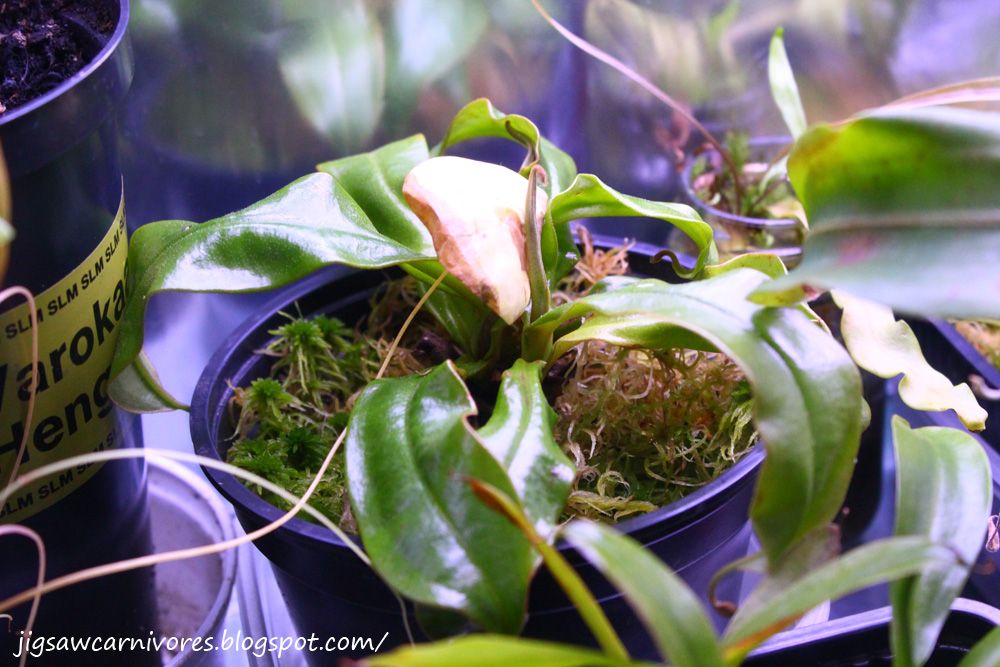 |
| N. ampullaria 'Brunei Red' x 'Harlequin' recovering. |
And the best for the last! Yesterday's packet, which included Darlingtonia californica, Drosera schizandra, Pinguicula crystalina, Pinguicula grandiflora and Sarracenia flava var rubricorpora, of which the first 2 are my most waited plants.
 |
| My Darling in a pot with diameter of 18cm (7") |
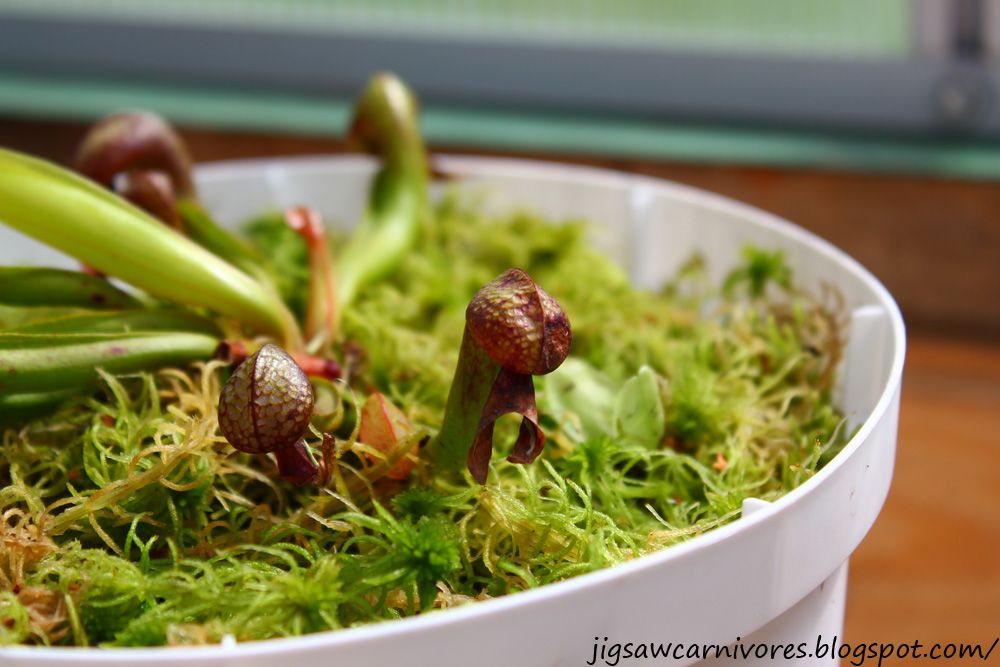 |
| Potting mix is pure sphagnum and the plant is potted in a big white plastic pot and placed im my greenhouse. |
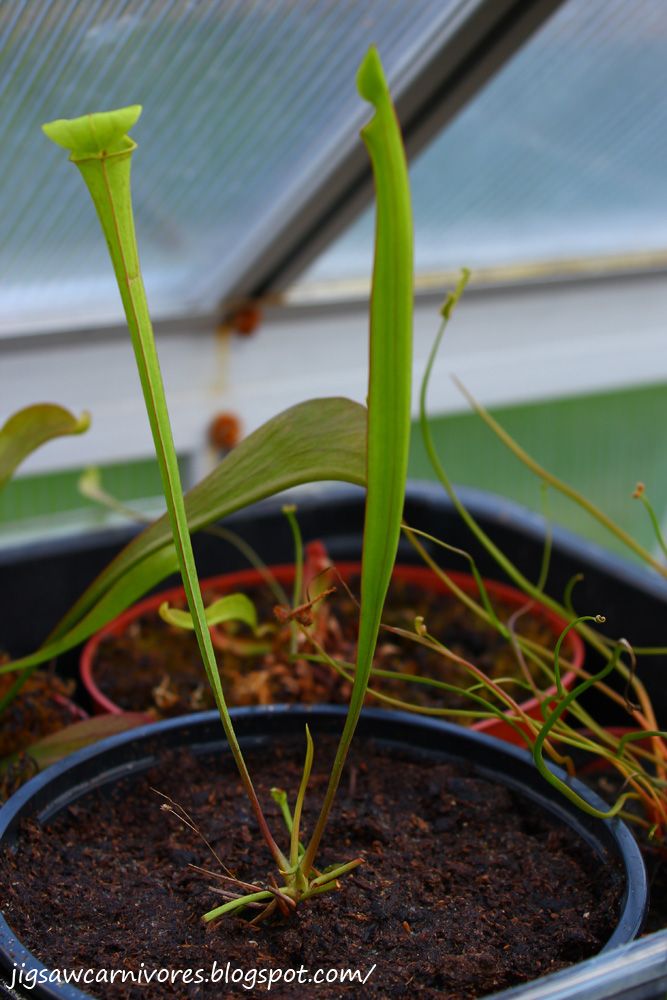 |
| Sarracenia flava. var. rubricorpora will hopefully show it's characteristic coloration later in this season. |
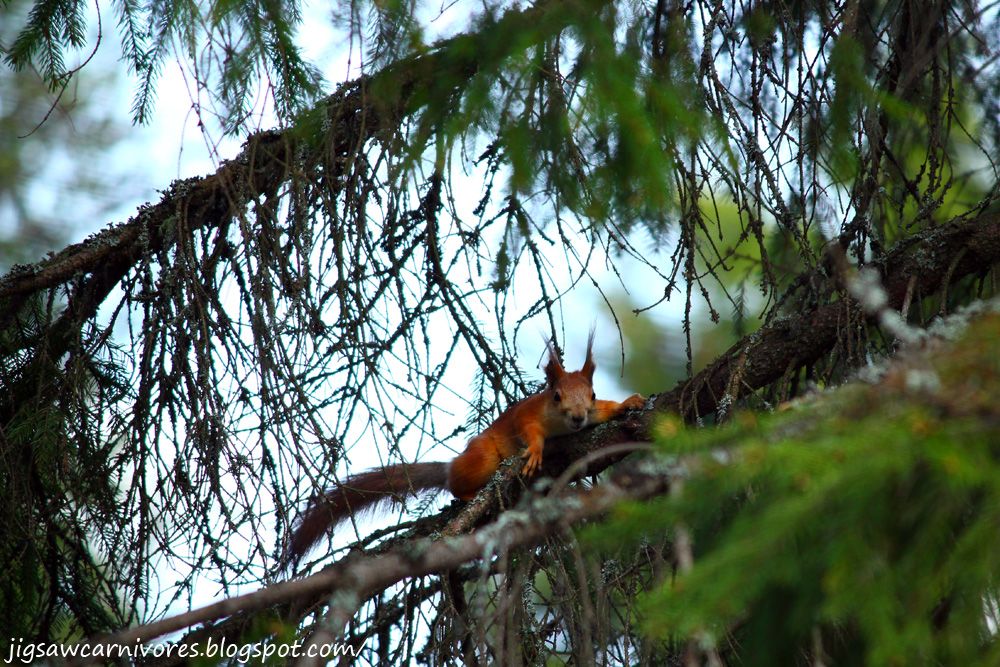 |
| "What are you taking pictures of? Get off my yard" |
Friday, May 24, 2013
Focusing on: Utricularia 'Lavinia Whateley'
Hello!
This is my first post in which I'm focusing only for one plant. The lucky plant to be chosen today was U. calycifida 'Lavinia Whateley.' I've owned this particular plant since 2011 and it is a very steady grower just like the typical U. calycifida.
This particular cultivar differs from the rest of it's species by having white flowers and plain green leaves instead of having any purple colored veins on top of their leaves. For fisrt year for me this plant did nothing but grow new leaves but afterwards started producing beautiful white flowers.
I'm not 100% sure about this but I think this plant likes the sandy top, which I use to prevent moss growing on my utrics. Soon after this plant received it's sand layer the plant started to grow another flowerstalk. Flooding this plant's tray seems to also make this plant happy and improve growth.

Flowers are about the same size as typical U. calycifida but without pinkish to violet coloration, which kinda makes the normal plant's flowers to seem more attractive. Flowers seem to be self fertile but I haven't got any seeds from this plant yet, so maybe helping the self pollination with a toothpick should do the trick. Just remember that if you self pollinate a cultivar and sell or swap the seeds you should not name them as their mother plant but motherplant x self.
.
Other registered cultivars of U. calycifida are for example U. 'Asenath Waite,' U. 'Cthulhu,' U. 'Yog-Sothoth' and U. 'Mrs. Marsh'This kind of update today but tomorrow I will write another one wtth stuff about my new plants.
Wednesday, May 15, 2013
Pinguicula primuliflora
Hello. Now just a quickie update because my new plant!
Today my growlist gained one more plant Pinguicula primuliflora, but lost one, Utricularia livida, which died for yet unknown reason. U. livida just got weaker and weaker until the plant was half dead so just in case I removed it from my growing area.

Today my growlist gained one more plant Pinguicula primuliflora, but lost one, Utricularia livida, which died for yet unknown reason. U. livida just got weaker and weaker until the plant was half dead so just in case I removed it from my growing area.

Sunday, May 12, 2013
Recognition -Tunnustus
So my blog got a recognition from Wune who keeps her blog Nepenthes blogi, a blog about growing carnivorous plants in Finland in Finnish and English. In this post 7 thing about my blog.
In English: Thank and link the blogger who gave you this recognition.
Kiitä antajaa ja linkitä bloggaaja, joka sinulle tunnustuksen antoi.
Valitse viisi ihanaa bloggaajaa, joilla on alle 200 lukijaa ja
kerro se heille jättämällä kommentti heidän blogiinsa.
Näin autamme uusia bloggaajia eteenpäin ja
ehkä juuri sinä löydät uuden upean blogituttavuuden
In English: Thank and link the blogger who gave you this recognition.
Choose five wonderful blogger with fewer than 200 followers and
tell it to them leaving a comment in their blogs.
This way we'll help new bloggers forward and
maybe you will find a new acquaintance.
The "challenge" came in Finnish but for my blog's main language is English I will make this challenge in both Finnish and English. First in English.
Here are the question with my answers and remember to answer the same question if you choose to accept the challenge. Then tag five blogs and see if they'll accept the challenge.
The "challenge" came in Finnish but for my blog's main language is English I will make this challenge in both Finnish and English. First in English.
Here are the question with my answers and remember to answer the same question if you choose to accept the challenge. Then tag five blogs and see if they'll accept the challenge.
1. When did you start your blog?
- 3rd of February in 2011. It was a cold winter day with too much snow.
2. Why did you start keeping a blog?
- Few other Finns started keeping their blogs about carnivorous plants so I thought it was worth trying.
2. Why did you start keeping a blog?
- Few other Finns started keeping their blogs about carnivorous plants so I thought it was worth trying.
3. Has your blog changed a lot since the beginning? How?
- Quite lot I think. I think at the moment I'm writing more stuff and maybe even in better English than before. Also I think I'm taking better pictures than I did before. Also the layout has changed a lot.
4. What does your blog mean to you?
- My blog is like a public diary about my hobby growing plants. If I sometimes wonder when was the last time this plant X grew this well and in what kind of conditions I can always check it from here. Also this blog is my own training project to write better English and to learn how to take better photos.
5. How have you ended up with your blog's current layout?
- Well the header photo in blog's early days looked a bit anemic so I started thinking of new picture to there. At that time I also received Cephalotus follicularis, which made such a beautiful looking pitcher, which was one of the most beautiful plants at the time. I took a photo and thought "Yeah! This looks good."
The background photo was at the time I received my macro add-on lens converter for my DSLR and started taking pictures with it. Picture of D. venusta's leaf failed a bit because I moved the camera while taking a photo. The result looked a bit funky though, some details but mostly very soft looking, which made it good background picture for my blog.
6. Of which subjects do you write most?
- Plants, plants plants, plants, plants, orchid, plants, cactus, plants. chilies etc.
7. What kind of blogs do you mostly read?
- Just about blogs that have same kind of subjects as mine has. Mainly carnivorous plant blogs, an orchid blog, bonsai blog and few general garden and/or plants blogs.
Ja sitten suomeksi. Vastatkaa näihin samoihin kysymyksiin. Sa vastata mutt' ei oo pakko hei!
1. Milloin perustit blogisi?
- 2011 helmikuun kolmas päivä.
2. Miksi perustit sen?
- Muutama muukin suomalainen aloitti pitämään blogia lihansyöjäkasveista. Kokeilin ja huomasin eetä täähän on ihan kivaa.
3. Onko blogisi muuttunut kovasti sen alkuajoista? Miten?
- Ulkoasu on muuttunut eniten. Luulen kirjoittavani nykyään enemmän ja parempaa englantia kuin alkuaikoina. Lisäksi kuvien laatu on tainnut parantua.
4. Mitä blogisi merkitsee sinulle?
- Tää on sellainen julkinen projekti, josta voin tarkistaa koska kasvi X on menestynyt hyvin ja missä olosuhteissa, sekä vertailla kasvukausia ja valaistuksien muutoksia paremmin. Lisäksi blogia pitäessäni kokoajan harjoittelen parempaa englannin kielen taitoa ja parempien valokuvien ottoa.
5. Miten olet päätynyt blogisi nykyiseen ulkoasuun?
- Yläkuvan otin samoihin aikoihin kun olin saanut Cephalotus follicularis-kasvin ja otin sen kauniista ansalehdestä kuvan ja ajattelin että "Jo-o. Tämä kelpaa."
Taustakuvan ottaessani kokeilin järkkäriini juuri tullutta makrolisäkettä, jolla otin kuvia mm.. D. venustasta. Kuva epäonnistui hiukan koska liikautin kameraa kuvanottoaikana ja lopputulos oli pehmeä, jossa on kuitenkin sopivasti yksityiskohtia.
6. Mistä aihesta kirjoitat blogiisi miluten?
6. Mistä aihesta kirjoitat blogiisi miluten?
- Kasveista, kasveista, orkidoista, kasveista, kaktuksista, kasveista, chileistä ja niin edespäin.
7. Millaisia blogeja itse luet mieluiten?
- Sellaisia jotka käsittelevät suurinpiirtein samoja aiheita kuin omani. Lihansyöjäkasveista, bonsaista, orkideoista ja ihan yleisesti kasveista kertovia blogeja.
Then I shall give my recognitions for following five blogs:
Thursday, May 09, 2013
Not dead yet! + New plants
Hello everybody!
First of all apologies for being not so active writing here but I have my reasons. I had the worst flu I've ever had with some fever(not Bieber fever, Justin Bieber visited Finland recently though and a friend of mine went to his concert and liked it) so I really had no energy to update this blog. I've also traveled a bit and working on some other important projects.
Summer is luckily just around the corner here in eastern Finland. Weather forecast shows that during next 10 days temperatures will range between +8 °C(46.4°F) and +15°C(59°F) during days and during nights between -1(30.2°F) and +5°C(41 °F ). In May I will move the main part of my collection to the greenhouse again and also receive some of the plants that I have already booked.
Now for the main course. I have a new terraria. This old aquarium is about 74 cm (29.1") long, 33 cm (12.9") wide and 36 cm (14.2") high so it can hold in about 85 liters of water, which is roughly 22.5 US gallons. Total price for this used aluminium framed aquarium with fluorescent light with a plant tube and a 80 cm(31.5") high table was just 35 euros which equals 46 USD.
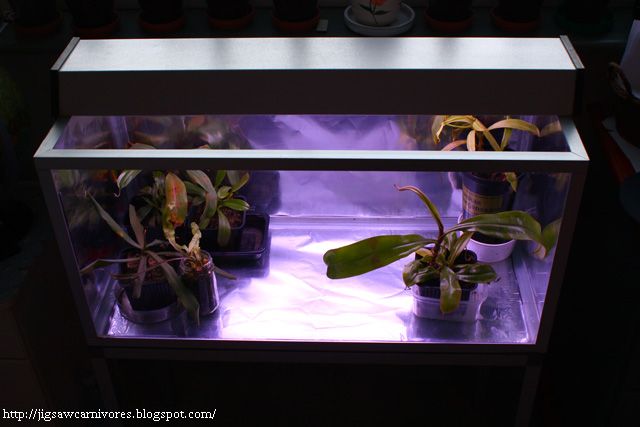
How the terraria looked soon after buying it.
The only things I really needed to add for this to work better with my plants were three walls and bottom of the terraria, which got aluminium foil cover to reflect light back to plants and make the terraria more eco friendly. Only things I need to make it work even better are the glass cover which I'm going to purchase when I have time during the next week, a PC fan from my old terrarium, a hygrometer and a thermometer. Without the glass cover humidity seems to stay between 50 and 60%, and I think my lowland nepenthes will appreciate higher humidity levels.
For now I've moved my Nepenthes pitcher plants into this new terraria. In their older growth space my Nepenthes didn't receive enough light nor humidity and that's why they look really sick now. The older terraria for Nepenthes was planned to be only temporary terrarium for them but my plans changed just a bit.
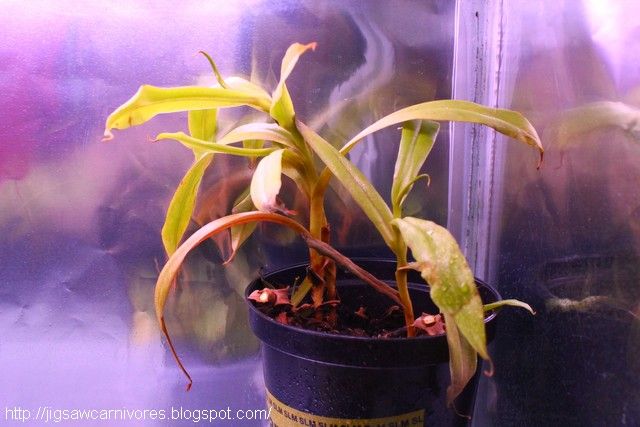
Nepenthes 'Rebecca Soper' looking a bit anemic. It will start pitcher production soon I hope.
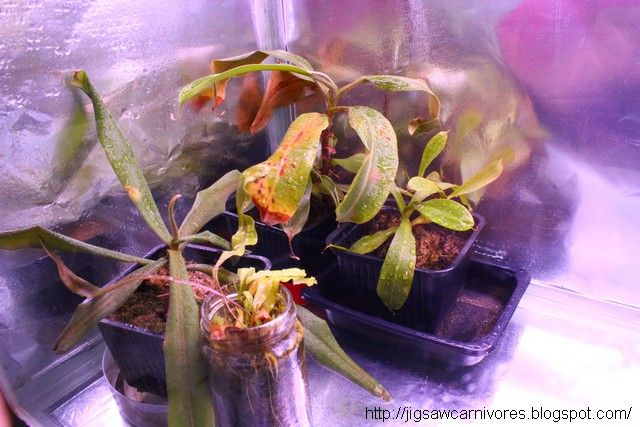
N. albomarginata, rafflesiana, x 'Ventrata' and Utricularia longifolia settling to their new growth space.
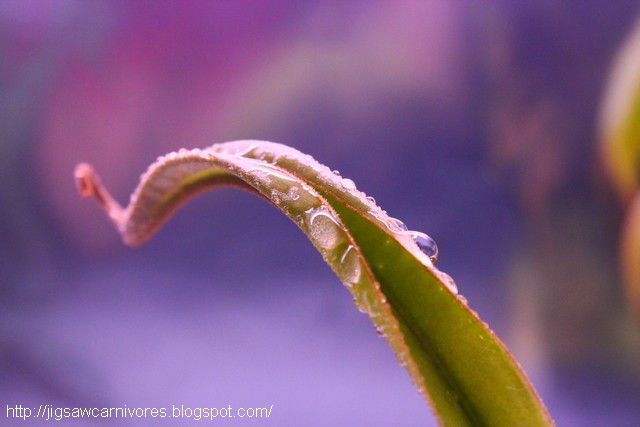
Trying something artistic with N. ampullaria 'Brunei Red x Harlequin'
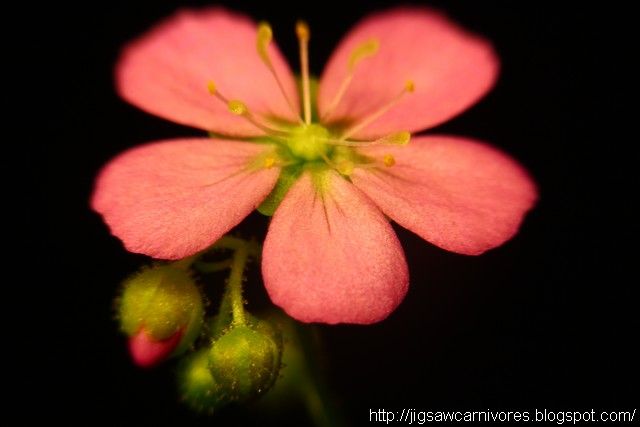
D. omissa x pulchella flowered again. Seriously, this is the easiest pygmy sundew I know. Maybe someday I could get few more easy to grow pygmy sundews. Any recommendations about which plants would fit in my criteria?
Now after lot of reading let me introduce you to my new plants.
Brocchinia reducta
D. filiformis
D. intermedia
D. intermedia x filiformis
D. rotundifolia
D. x 'obovata'
G. aurea
G. filiformis
G. hispidula
G. flexuosa 'Furnas, Minas Gerais'
G. roraimensis 'Cerro Huachamacari'
U. biloba
U. dichotoma
U. flaccida
U. minutissima 'Gunung Jerai'
U. minutissima 'Gunung Tahan'
U. monanthos
U. prehensilis
U. tricolor
U. spec. Hermanus
Thank you Krzysztof Ciesielski!
After a while my all new terraria looked like this:
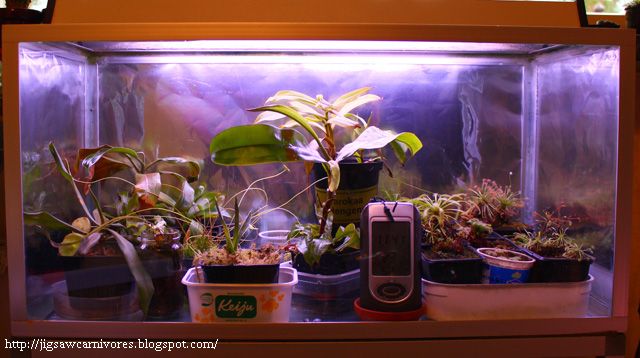
I think I already need to get second and even third old aquarium to transform into a terraria. Two other terraria I have are two plastic storage boxes covered with aluminium foil, lit by megaman plant ESL with so far good results.
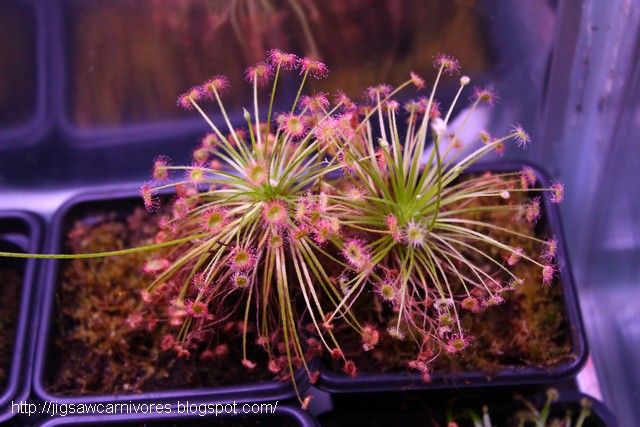
Couple of D. paradoxa are at last warming up to each other and are flowering at the same time. Hope to have seeds if I succeed in cross pollinating them.
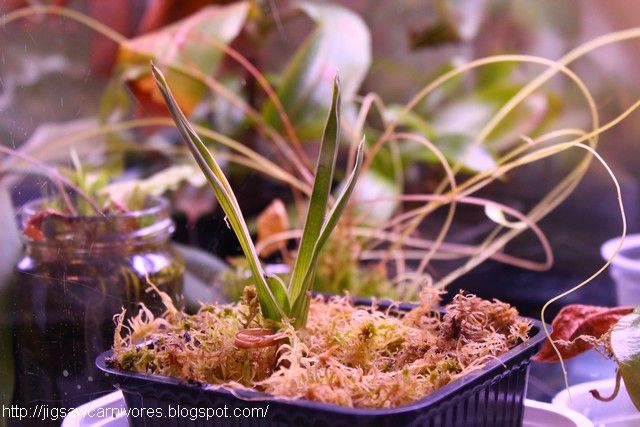
Brocchinia reducta will be in terraria for a while until I will move it on my windowsill and greenhouse.

The 5 Genlisea cousins, from top left corner clockwise G. hispidula, G. filiformis, G. roraimensis 'Cerro Huachamari', G. flexuosa 'Furnas, Minas Gerais, Brazil' and G. aurea. lower corner of this pic there are also 2 blurry soon to bloom D. tomentosas.
As we Finns say in form of an old folk poem which was kind of a rule of when there's summer in Finland:
Kuu kiurusta kesään
puoli kuuta peipposesta
västäräkistä vähäsen
pääskysestä ei päivääkään.
or in English:
Moon to summer from skylark
half moon less from finch
from wagtail not too long
from swallow not a day.
The swallows have returned to Finland, so in other words summer is also here here. In summer I will again take most of my collection outdoors or to greenhouse. I have made blueprints for my bog garden and will soon turn it into reality.
We get more light and plants start to grow better after a long winter so there will me more updates and it will surely not take me another 2 months or how long was it again, to make a new blog post.
Happy growing. Give lots of sunlight to your plants and also to yourself!
First of all apologies for being not so active writing here but I have my reasons. I had the worst flu I've ever had with some fever(not Bieber fever, Justin Bieber visited Finland recently though and a friend of mine went to his concert and liked it) so I really had no energy to update this blog. I've also traveled a bit and working on some other important projects.
Summer is luckily just around the corner here in eastern Finland. Weather forecast shows that during next 10 days temperatures will range between +8 °C(46.4°F) and +15°C(59°F) during days and during nights between -1(30.2°F) and +5°C(41 °F ). In May I will move the main part of my collection to the greenhouse again and also receive some of the plants that I have already booked.
Now for the main course. I have a new terraria. This old aquarium is about 74 cm (29.1") long, 33 cm (12.9") wide and 36 cm (14.2") high so it can hold in about 85 liters of water, which is roughly 22.5 US gallons. Total price for this used aluminium framed aquarium with fluorescent light with a plant tube and a 80 cm(31.5") high table was just 35 euros which equals 46 USD.

How the terraria looked soon after buying it.
The only things I really needed to add for this to work better with my plants were three walls and bottom of the terraria, which got aluminium foil cover to reflect light back to plants and make the terraria more eco friendly. Only things I need to make it work even better are the glass cover which I'm going to purchase when I have time during the next week, a PC fan from my old terrarium, a hygrometer and a thermometer. Without the glass cover humidity seems to stay between 50 and 60%, and I think my lowland nepenthes will appreciate higher humidity levels.
For now I've moved my Nepenthes pitcher plants into this new terraria. In their older growth space my Nepenthes didn't receive enough light nor humidity and that's why they look really sick now. The older terraria for Nepenthes was planned to be only temporary terrarium for them but my plans changed just a bit.

Nepenthes 'Rebecca Soper' looking a bit anemic. It will start pitcher production soon I hope.

N. albomarginata, rafflesiana, x 'Ventrata' and Utricularia longifolia settling to their new growth space.

Trying something artistic with N. ampullaria 'Brunei Red x Harlequin'

D. omissa x pulchella flowered again. Seriously, this is the easiest pygmy sundew I know. Maybe someday I could get few more easy to grow pygmy sundews. Any recommendations about which plants would fit in my criteria?
Now after lot of reading let me introduce you to my new plants.
Brocchinia reducta
D. filiformis
D. intermedia
D. intermedia x filiformis
D. rotundifolia
D. x 'obovata'
G. aurea
G. filiformis
G. hispidula
G. flexuosa 'Furnas, Minas Gerais'
G. roraimensis 'Cerro Huachamacari'
U. biloba
U. dichotoma
U. flaccida
U. minutissima 'Gunung Jerai'
U. minutissima 'Gunung Tahan'
U. monanthos
U. prehensilis
U. tricolor
U. spec. Hermanus
Thank you Krzysztof Ciesielski!
After a while my all new terraria looked like this:

I think I already need to get second and even third old aquarium to transform into a terraria. Two other terraria I have are two plastic storage boxes covered with aluminium foil, lit by megaman plant ESL with so far good results.

Couple of D. paradoxa are at last warming up to each other and are flowering at the same time. Hope to have seeds if I succeed in cross pollinating them.

Brocchinia reducta will be in terraria for a while until I will move it on my windowsill and greenhouse.

The 5 Genlisea cousins, from top left corner clockwise G. hispidula, G. filiformis, G. roraimensis 'Cerro Huachamari', G. flexuosa 'Furnas, Minas Gerais, Brazil' and G. aurea. lower corner of this pic there are also 2 blurry soon to bloom D. tomentosas.
As we Finns say in form of an old folk poem which was kind of a rule of when there's summer in Finland:
Kuu kiurusta kesään
puoli kuuta peipposesta
västäräkistä vähäsen
pääskysestä ei päivääkään.
or in English:
Moon to summer from skylark
half moon less from finch
from wagtail not too long
from swallow not a day.
The swallows have returned to Finland, so in other words summer is also here here. In summer I will again take most of my collection outdoors or to greenhouse. I have made blueprints for my bog garden and will soon turn it into reality.
We get more light and plants start to grow better after a long winter so there will me more updates and it will surely not take me another 2 months or how long was it again, to make a new blog post.
Happy growing. Give lots of sunlight to your plants and also to yourself!
Wednesday, February 20, 2013
I want your opinion!
My dear readers. For me it is very relaxing and enjoyable to write things down in here about my hobby and I also hope that you enjoy reading my experiences, though I'm not a professional, just a simple carnivorous plants hobbyist from country of Finland. Now this simple hobbyist wants to make this blog even better just to celebrate the second anniversary of my blog. Actually the second anniversary of this blog was 3rd of February.
Do you have an idea that could make this blog even better?
From which plants do you especially want posts of?
Do you want to see more plants that are cultivated or more plants in the wild?
Please tell me about your opinions and interests.
Please write me a comment or send me an e-mail to kihokki01[at]gmail.com
Yours
DW
Do you have an idea that could make this blog even better?
From which plants do you especially want posts of?
Do you want to see more plants that are cultivated or more plants in the wild?
Please tell me about your opinions and interests.
Please write me a comment or send me an e-mail to kihokki01[at]gmail.com
Yours
DW
Tuesday, February 19, 2013
Macro shots
Hello everybody!
Recently I purchased a macro lens adapter, which is basically just 2 adapter pieces, one for the camera and one for the lens and 3 aluminum tubes. The magic this adapter set does is it makes it possible to focus the lens closer than normally by moving the lens further from the camera body. The set cost me only about 6€ or 8$.
Here are some flowers and other small details of carnivorous plants that I took photos of.
Flower of Drosera paradoxa
Drosera venusta
Drosera tomentosa Morro do Jambeiro, Grao Mogol, Minas Gerais, Brazil
Pinguicula emarginata x (moranensis x ehlersiae) leaf with a mosquito. In the middle of the winter there's a mosquito on my pinguicula's leaf. Could this possibly be a Culex pipiens molestus, a.k.a. London Underground mosquito, which can possibly lay eggs in any place with standing water?

Flower of Pinguiula emarginata x (moranensis x ehlersiae).
Another flower of Pinguicula emarginata x (moranensis x ehlersiae)
Flower of Pinguicula emarginata
Flower of Utricularia livida 'Blue'
Flower bud of Pinguicula moctezumae
A tiny drop of water on Utricularia nelumbifolia x remiformis, showing hydrofobic properties of leaves of this plant. So far I have not seen a trait like this on my individuals of U. nelumbifolia or U. reniformis.
Leaves of Utricularia pubescens .
Flower of Utricularia nephrophylla.
I want to especially thank my readers from the United States of America for following my blog. At the moment I see that my flag counter on the right navigation bar shows 526 hits from the US and 525 hits from Finland. Also thank you readers from other countries as well for following my green life.
Spring is starting here because the temperature at the moment is only slightly over zero celsius. Soon the snow starts to melt and summer returns to the north again.
Have a happy spring!
Subscribe to:
Posts (Atom)







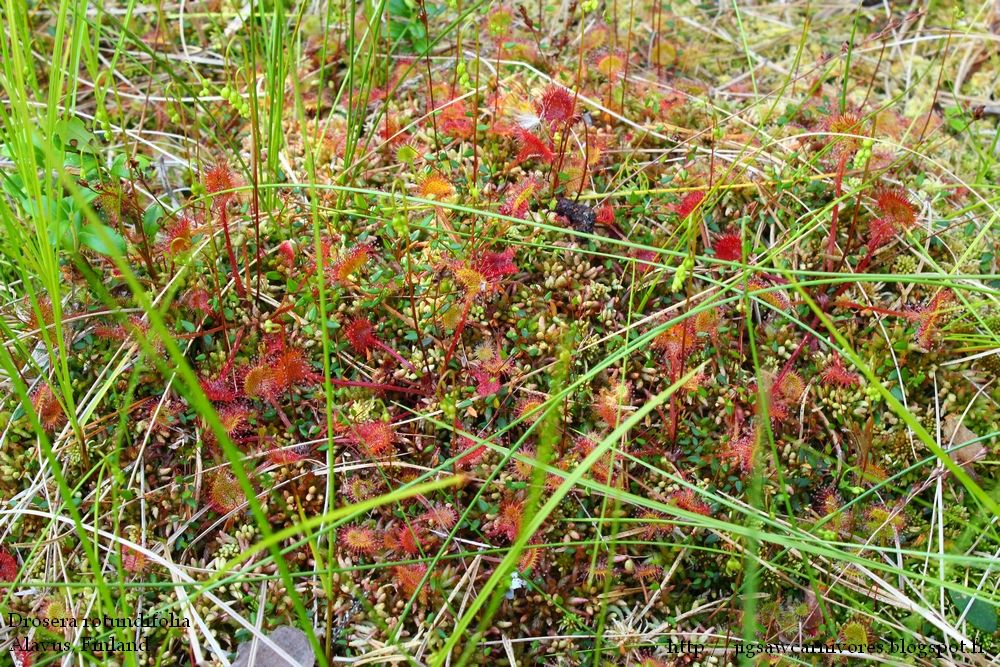
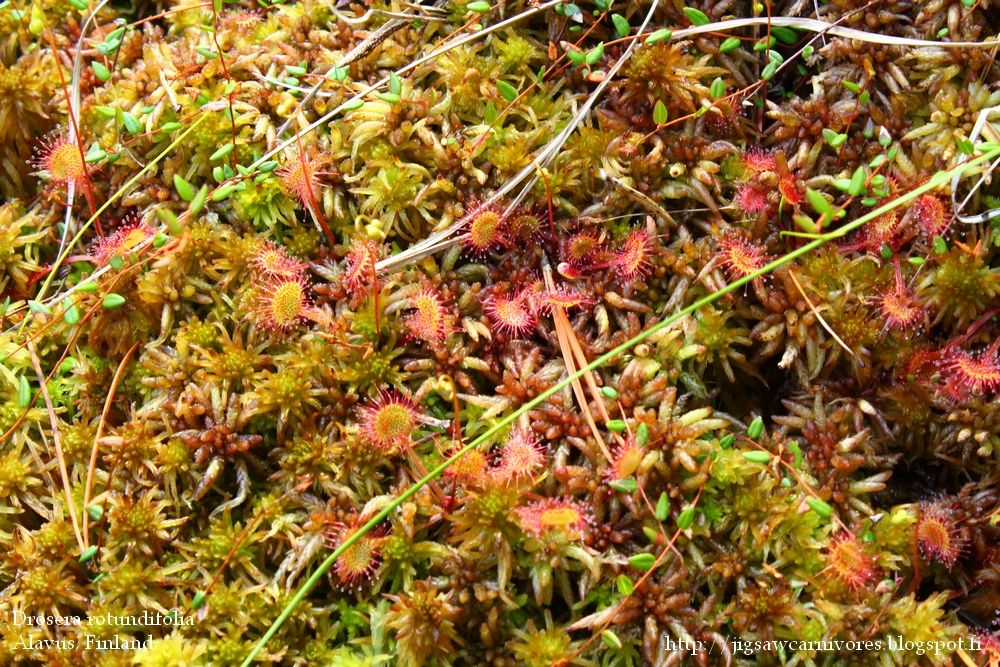
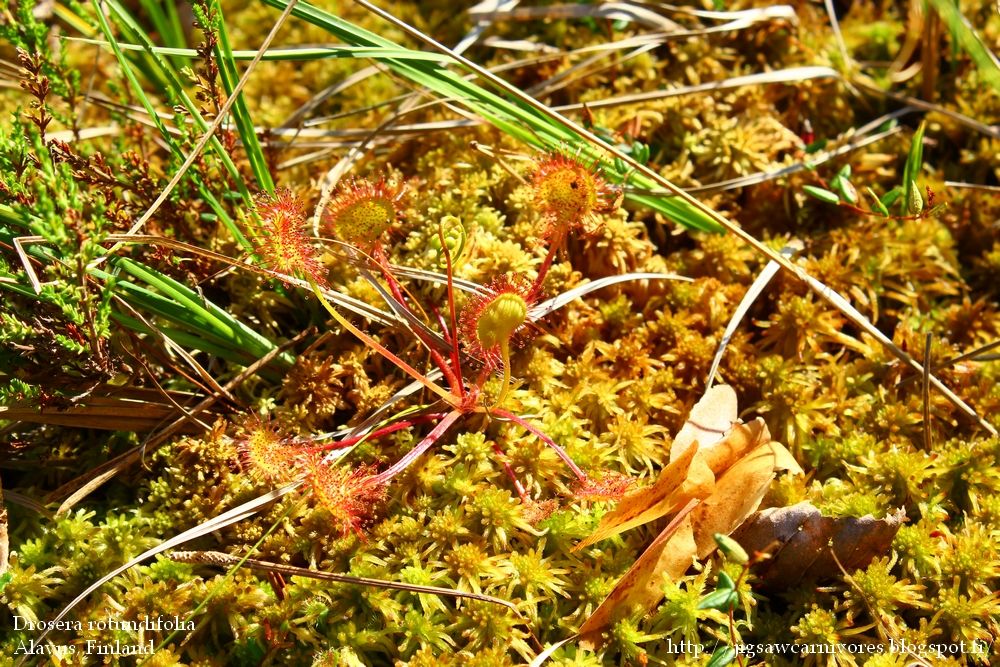
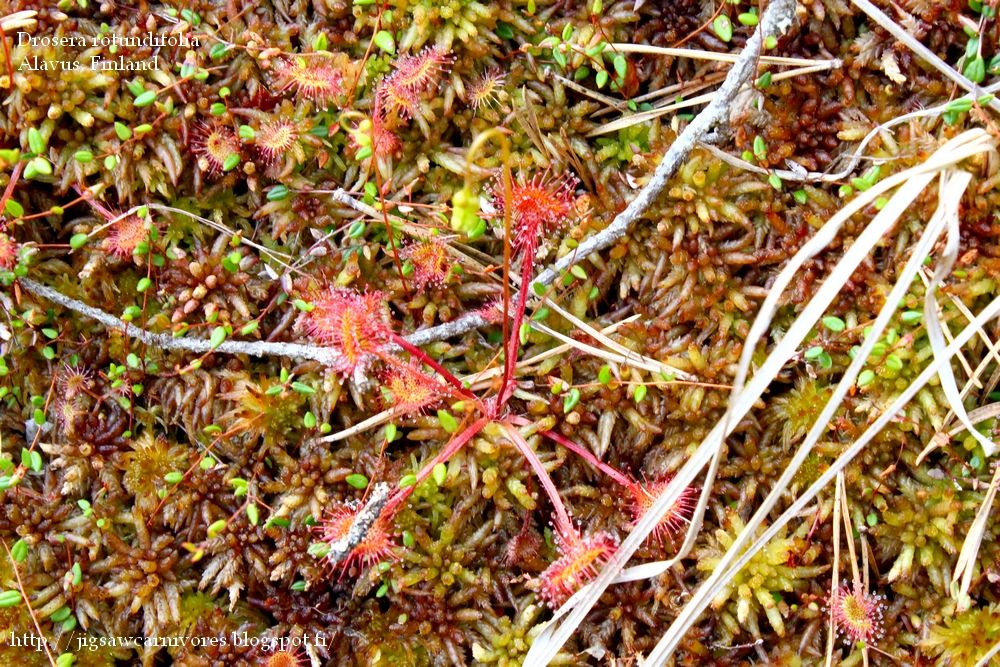

.JPG)











